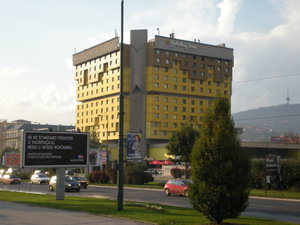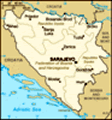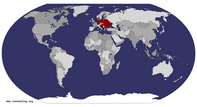Advertisement
Published: October 23rd 2008

 The most famous Holiday Inn in the world
The most famous Holiday Inn in the world
Home to journalists during the war, the stretch of road in front was known as sniper alley.As well as being the catalyst for this entire journey, Sarajevo is the most incredible city I have ever seen or am likely to see in my lifetime. And I can go anywhere I want. But between April 1992 and late 1995, the only way in or out of this city was by sprinting across an airport runway or by queuing for hours to go through an underground tunnel, hoping not to be hit by bullets. The longest siege in human history saw over 10,000 killed and about 50,000 wounded as the Yugoslav People's Army and Bosnian Serb forces occupied the hills around the city. Using tanks, mortars and sniper fire to target civilians, the attackers wanted to break the spirit of the people to reclaim the city for the Republic Srpska, an area of Bosnia and Hercegovina.
I'm no historian and I wasn't really old enough to fully understand the horrors unfolding on the news every night. But it is hard not to go into the siege as the terrible realities of war contrast so with the beautiful, tolerant and friendly city that is a pleasure to walk around today.
We arrived late on Wednesday night after a cramped bus journey from Belgrade, and took a taxi from the bus station to what we thought was our hostel in the Turkish quarter of the town. It was, of sorts, but after checking in with a non-English speaking member of staff we were marched five minutes around the corner to an apartment block, where it emerged that we would basically be staying in the front room of a kindly elderly lady we nicknamed "Nan" because of her grandmotherly nature. We woke here up (It was 11.30pm) but she still cheerfully made our beds and despite not speaking any English, tried to welcome us. She also said "Dobra" (Bosnian for good) a lot, which we imitated on plenty of occasions over the following few days.
The following day, Sarajevo was bathed in warm October sunshine and we strolled around the historic centre where mosques and churches are within metres of each other and stylish young people filled pavement cafes at lunchtime.
There is a lot more significance to this city than the Balkan wars of the early 1990s of course. We took the short walk to the Miljacka river, over which runs the famous Latin Bridge. In 1914, Archduke of Austro-Hungary Franz Ferdinand was assassinated by a Bosnian Serb, Gavilo Princip, sparking off the First World War. There was a bust of the Archduke and a plaque, but neither remain today. Princip's ethnicity was a catalyst for the plaque being ripped off during the siege. Further east is the national library. The Archduke stopped off here on his way to the bridge. More recently, in 1992, it was hit badly by bombs and two million publications were lost forever in the resulting inferno. It is still being restored today and is not yet open. A plaque acknowledges the shelling and blames "Serb criminals".
A 20 minute walk west of here is the Holiday Inn hotel, immortalised by pictures beamed around the world during the siege. This was the only hotel operating during that time and as such was the base for foreign journalists. The stretch of road running past it to the south was nicknamed "sniper alley" because it is exposed to the hills on the other side of the river, from where snipers would pick off civilians as they sprinted across the wide, open street. Pock-marked buildings still line that section of road, although much has now been repaired. I felt uneasy about taking photographs - the war is still a very sensitive subject here and understandably some resentment still simmers. The city has done a good job of restoring and rebuilding areas very badly damaged, the parliament building opposite the Holiday Inn being a prime example, unrecognisable after being gutted by fire during the siege.
Populated by about 700,000 people, Sarajevo is an easy place to walk around and we soon found our way back to the centre, visiting a couple of excellent English language bookshops on the way. North of the river, on Ulica Marsala Tita, is the Markale market. It was closing when we saw it around 5.30pm, with fruit and veg sellers busily packing away for the day. At the back is a large red mural with a list of names, those who died when the market was shelled twice during the siege, first in February 1994 and again the following year. More than 100 were killed, and the second atrocity prompted long-overdue action from NATO as it was a designated "safe zone". A few months later following air strikes on the Bosnian Serb positions, the city was free again.
The people here are cheerful and friendly. A few, noticing we were tourists (we seem to stick out a mile everywhere), stopped to offer us some guidance, including a man who looked a bit like Skeletor off Masters of the Universe, whom we kept bumping into over the following days suspiciously always wearing the same clothes.
Primary ambition for Friday was seeing the history museum near the Holiday Inn. The weather turned sour on our long walk there, but despite having failed to bring our jackets, the drenching to my new souvenir Sarajevo t-shirt was not too extreme. The museum, which cheekily charges foreigners three times the amount due by locals (my cunning Bosnian was not enough to fool the attendant), is basically two exhibitions. One on the history of the country as a whole, which seems to have changed hands more times than brown envelopes in the office of George Graham, the other dedicated to the siege.
I don't like to go on about that time, Sarajevo has moved on impressively since, and after all you've all got access to Wikipedia. But it was such a testament to the pride Sarajevans had in their city and their bravery that an army made up of football supporters, ex-convicts and police divisions held out for nearly four years against one of the biggest armies in the world. All the while, electricity, water and heat was cut off and constant shelling from the surrounding hills bombarded homes and buildings. The Serb forces deliberately targeted hospitals, schools, fuel companies and civilians to try and make life intolerable. People tried to live their lives as normally as they could in defiance of the attacks. I don't particularly enjoy my commute but at least I don't have heavily-armed marksmen taking aim at me from the sides of the A130. But people dodged the fire to get to work or school to buy what little food was available. Incredible courage, and the exhibition was an excellent insight into how people survived those years. The schoolbooks and materials with dried blood on them were particularly disturbing.
On our way back, we lunched at the Holiday Inn before heading back to the Sarajevo brewery just across the river from the Turkish quarter. The city is justly proud of its Sarajevsko Pivo, which comes in light or dark (Si drew a perplexed reaction from the waiter when ordering a "negro pivo" - the correct term is apparently crno) and is sold everywhere in the city. The brewery contains a massive, grand public bar which reminded us a lot of Wetherspoons pubs without the smell of vomit, incapable staff and old men banging their fists against the bar demanding Theakstons. When we arrived it was quiet but the waiters were visibly taken aback when two coachloads of tourists arrived and a blonde woman in her 30s, presumably the manager, had to get on the phone to call for backup. Well, who doesn't want a pint (sorry, half litre) at 5pm on a Friday afternoon?
The next day we flagged down a cab and headed towards the airport for one of the most remarkable reminders of the siege anywhere in the city. With people being killed trying to sprint across the airport runway to the 'free' area, the Bosnian army began to dig a secret tunnel beneath to get supplies and people in and out. By July 1993, after four months of construction using only shovels and pick-axes, it was complete. 800m long, 1.6m high and a metre wide, it undoubtedly saved thousands of lives. An average 4,000 people passed through a day, carrying up to 50 kilograms of food and supplies bought mainly from neighbouring Croatia. Later, it carried electricity and fuel supply lines. Most of it has now collapsed, but a 25m section at the entrance inside a suburban house has been preserved by the family who lived there and helped build it. Some of the carts used to transport goods have been preserved as well as other artefacts and military uniforms. We spent an hour looking around and walked through the remaining section of the tunnel before our nominated taxi driver took us back to the city centre, where we hopped around a few bars trying unsuccessfully to find one showing England v Kazakhstan.
That evening, we settled into a small bar to watch Bosnia and Hercegovina take on Turkey - I had a vested interest as I had cold hard cash on the visitors as part of a five game accumulator, but I wasn't about to tell the locals that. Sat at the back whilst watching the Turks come back from a goal down to win 2-1, we noticed British-sounding voices to our right. Sure enough, it was two lads from Portsmouth who were out on holiday. We had a few drinks with them and swapped travel stories before going our separate ways.
We had intended to have a big Saturday night out here but the bars we chose were too cramped and smoky to be enjoyable, so we abandoned the idea and returned chez Nan at around midnight.
On our last day we had hoped to get to a curry house but we discovered, fortunately before we had trekked 20 minutes out of town to get there, that it didn't open until 5pm. With our train due to leave for Mostar at 6pm, it was too risky so we made do with the Holiday Inn again. After a leisurely meal taken outside in the hot sunshine we lugged our ever increasing loads to the train station. It was time to say goodbye to what we both agreed was our favourite destination so far.
Sarajevo has everything, cool bars, fine restaurants, a shed load of history and plenty of natural and man-made beauty. But the best thing about this place is it renews your faith in the human spirit. People of all religions live side by side, and everyone is friendly and optimistic. The city bears some scars, but it is amazing to think that less than 15 years ago it was facing oblivion. You come to Sarajevo curious, you leave feeling invincible.
Advertisement
Tot: 0.094s; Tpl: 0.011s; cc: 10; qc: 52; dbt: 0.0542s; 1; m:domysql w:travelblog (10.17.0.13); sld: 1;
; mem: 1.2mb









